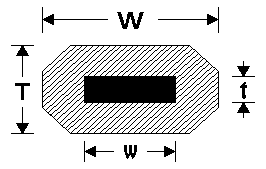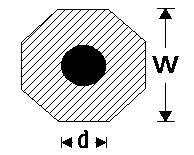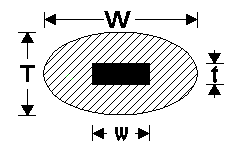

A carpenter's pencil has at least two essential characteristics which distinguish it from other types of specialty pencils. First, the shape of a carpenter's pencil prevents it from rolling, even when placed on a steep sloping roof. The most popular shape seems to be a flat, octagonal style. Secondly, the lead must be strong enough to make a heavy mark and to withstand the stresses of carpentry, which frequently requires marking on very coarse surfaces. The leads are usually wide and flat.
Figure 1 shows the typical shape of the most popular style of carpenter's pencil. Most such pencils are painted red or yellow and carry the logo of a lumber supplier or tool maker, and rarely indicate their source of manufacture. This is the most common style in the US, and is also common in the UK. I have one specimen which differs only slightly from Fig. 1 in that the lead is not rectangular, but has rounded corners, and another with a large round lead approx. 5/32" (4mm) in diameter.
 Fig. 1 - Typical dimensions for this style are as follows: W=19/32" (15mm), T=1/4" (6.3mm), w=1/4" (6.3mm), t=3/32" (2.4mm). Most such pencils are 7" (178mm) in length.
Fig. 1 - Typical dimensions for this style are as follows: W=19/32" (15mm), T=1/4" (6.3mm), w=1/4" (6.3mm), t=3/32" (2.4mm). Most such pencils are 7" (178mm) in length.
One pencil manufacturer, Dixon, makes carpenter pencils with their name on them, 'Dixon Red and Black 997-M', in this style. I have two such Dixon's, one with the above dimensions, the other is slightly smaller: W=1/2" (12.7mm), T=1/4" (6.3mm), w=3/16" (4.8mm), t=1/16" (1.6mm). Both are painted red with black longitudinal striping. Stephen Axbey reports that a UK manufacturer, Cumberland, also makes a similar style. A third Dixon brand, which I recently acquired (from the bottom of an old tool box at an antique mall) has the same outer dimensions as the smaller specimen above, is reddish-brown in color, and imprinted with "Dixon's Framers 538-H Hard". When they said hard, they meant it - I can barely make a mark on ordinary paper with its sharpened point.
I have several other pencils which I classify as carpenter's pencils, though their intended use is uncertain. One specimen is of large octagonal cross section, as in Fig. 2. The unpointed end has a metal, round-ended ferrule. The pencil is imprinted with the following:
 Fig. 2 - Dimensions: W=5/8" (16mm), d=1/8" (3.2mm). In the hand-sharpened condition in which I received it, this pencil is approximately 9" (229mm) in length. It was given to me by an acquaintance; its origin is unknown to me. However, I do have another pencil having the same outer dimension, but with a 1/4" (6.3mm) diameter lead, made by the Eagle Pencil Company and imprinted with "JUST FOR FUN". The ferrule is nearly identical, except it also has a metal ring attached to it, so I am guessing the 'Beaver' pencil may have been made by Eagle.
Fig. 2 - Dimensions: W=5/8" (16mm), d=1/8" (3.2mm). In the hand-sharpened condition in which I received it, this pencil is approximately 9" (229mm) in length. It was given to me by an acquaintance; its origin is unknown to me. However, I do have another pencil having the same outer dimension, but with a 1/4" (6.3mm) diameter lead, made by the Eagle Pencil Company and imprinted with "JUST FOR FUN". The ferrule is nearly identical, except it also has a metal ring attached to it, so I am guessing the 'Beaver' pencil may have been made by Eagle.
I also have two elliptical pencil styles (see Fig. 3) which I classify as carpenter's pencils because of their wide, rectangular lead. They have the following dimensions:
 Fig. 3
The larger has a natural wood finish with no markings whatsoever, the smaller is a red China-made 'Youth 800'. I encountered a third elliptical style with measurements about halfway between these two. Of two specimens, one is unmarked, the other a a barely distinguishable "DIXON'S 410" imprinted on it. I don't know if these are truly carpenter's pencils, or if they are for artists, or for some other special purpose.
Fig. 3
The larger has a natural wood finish with no markings whatsoever, the smaller is a red China-made 'Youth 800'. I encountered a third elliptical style with measurements about halfway between these two. Of two specimens, one is unmarked, the other a a barely distinguishable "DIXON'S 410" imprinted on it. I don't know if these are truly carpenter's pencils, or if they are for artists, or for some other special purpose.Sandra Suppa, of FABER-CASTELL GmbH & Co., Germany, has provided a photograph of an old carpenters pencil, which is believed to be the oldest pencil still in existence.
If anyone has additional information about carpenter's pencils, especially those made outside the US, please contribute to this article. As with all the Pencil Pages, additions and corrections are welcome.
